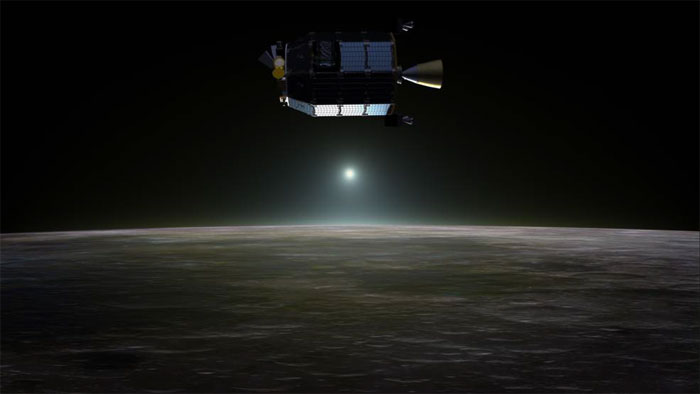.

The moon's thin atmosphere contains neon, a gas commonly used in electric signs on Earth because of its intense glow. While scientists have speculated on the presence of neon in the lunar atmosphere for decades, NASA's Lunar Atmosphere and Dust Environment Explorer (LADEE) spacecraft has confirmed its existence for the first time.
"The presence of neon in the exosphere of the moon has been a subject of speculation since the Apollo missions, but no credible detections were made," said Mehdi Benna of NASA's Goddard Space Flight Center in Greenbelt, Maryland and the University of Maryland, Baltimore County. "We were very pleased to not only finally confirm its presence, but to show that it is relatively abundant." Benna is lead author of a paper describing observations from LADEE's Neutral Mass Spectrometer (NMS) instrument published May 28 in Geophysical Research Letters.
There's not enough neon to make the moon visibly glow because the moon's atmosphere is extremely tenuous, about 100 trillion times less dense than Earth's atmosphere at sea level. A dense atmosphere like Earth's is relatively rare in our solar system because an object has to be sufficiently massive to have enough gravity to hold onto it.
The behavior of a dense atmosphere is driven by collisions between its atoms and molecules. However, the moon's atmosphere is technically referred to as an exosphere because it’s so thin, its atoms rarely collide. Exospheres are the most common type of atmosphere in our solar system, so scientists are interested in learning more about them. "It's critical to learn about the lunar exosphere before sustained human exploration substantially alters it," Benna said. Since the moon's atmosphere is so thin, rocket exhaust and outgassing from spacecraft could easily change its composition.
Most of the moon's exosphere comes from the solar wind, a thin stream of electrically conducting gas blown from the surface of the sun into space at around a million miles per hour. Most of the solar wind is hydrogen and helium, but it contains many other elements in small amounts, including neon. All these elements impact the moon, but only helium, neon, and argon are volatile enough to be returned back to space. The rest of the elements will stick indefinitely to the moon’s surface.
The LADEE NMS instrument confirms that the moon’s exosphere is made up of mostly helium, argon, and neon. Their relative abundance is dependent on the time of day on the moon--argon peaks at sunrise, with neon at 4 a.m. and helium at 1 a.m. The instrument conducted systematic measurements of these gases for seven months, which allowed the team to understand how these gases are supplied to the exosphere, and how they are ultimately lost.
While most of the lunar exosphere comes from the solar wind, NMS showed that some gas comes from lunar rocks. Argon-40 results from the decay of naturally occurring radioactive potassium-40, found in the rocks of all the terrestrial planets as a leftover from their formation.
"We were also surprised to find that argon-40 creates a local bulge above an unusual part of the moon's surface, the region containing Mare Imbrium and Oceanus Procellarum," said Benna. Although the reason for this local enhancement is not yet understood, "One could not help to notice that this region happens to be the place where potassium-40 is most abundant on the surface. So there may be a connection between the atmospheric argon, the surface potassium and deep interior sources," said Benna.
A second surprising behavior of argon was that the overall amount in the lunar exosphere was not constant over time. Instead, it increased and then decreased by about 25 percent during the course of the LADEE mission. According to Benna, this transient source of argon may be the result of enhanced outgassing from the surface that is triggered by tidal stress on the moon.
NMS also revealed an unexpected source of some of the helium in the lunar exosphere. "About 20 percent of the helium is coming from the moon itself, most likely as the result from the decay of radioactive thorium and uranium, also found in lunar rocks," said Benna. This helium is being produced at a rate equivalent to about seven liters per second at standard atmospheric pressure.
"The data collected by the NMS addresses the long-standing questions related to the sources and sinks of exospheric helium and argon that have remained unanswered for four decades," said Benna. "These discoveries highlight the limitations of current exospheric models, and the need for more sophisticated ones in the future."
Launched in September 2013 from NASA's Wallops Flight Facility in Virginia, LADEE began orbiting the moon Oct. 6 and gathering science data Nov. 10. The spacecraft entered its science orbit around the moon's equator on Nov. 20, and in March 2014, LADEE extended its mission operations following a highly successful 100-day primary science phase. LADEE lacked fuel to maintain a long-term lunar orbit or continue science operations and was intentionally sent into the lunar surface, impacting the moon on April 17, 2014. The spacecraft's orbit naturally decayed following the mission's final low-altitude science phase.
Quelle: NASA
4601 Views
